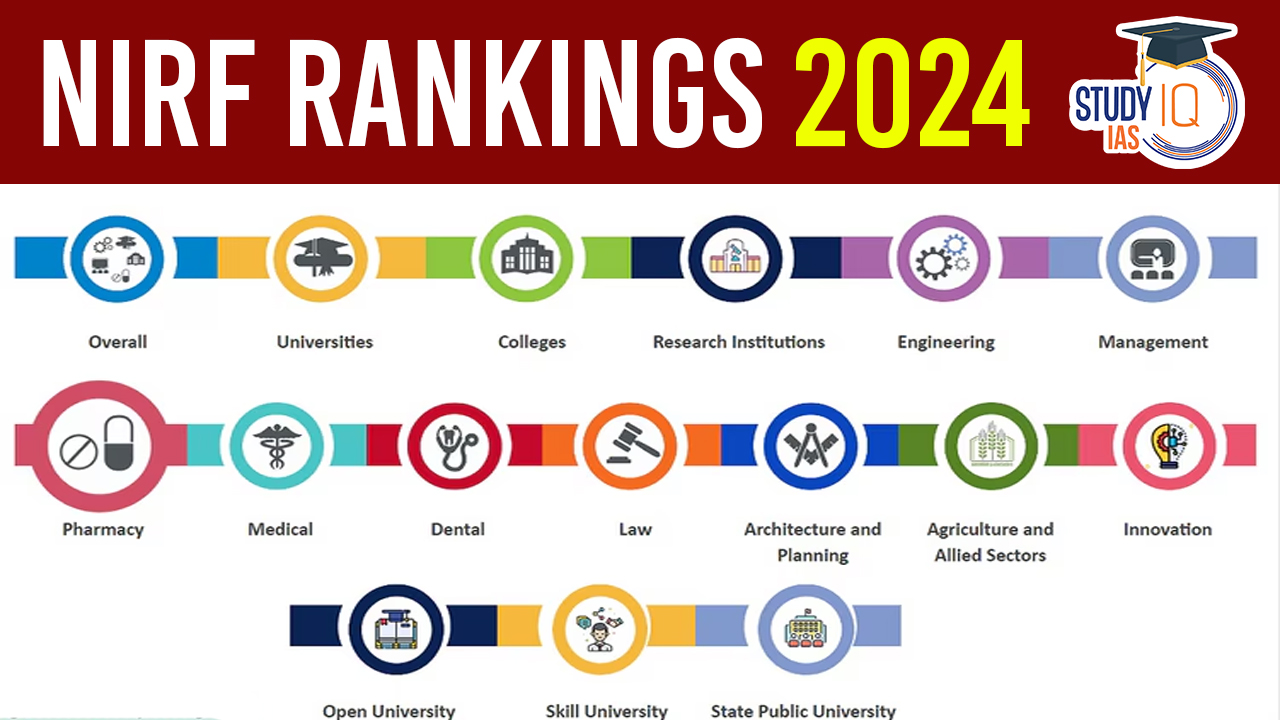Table of Contents
NIRF Rankings for 2024
NIRF Rankings for 2024 are released by the Union Education Minister.
- The Indian Institute of Technology, Madras is the best educational institution in the country for the sixth time since 2019
- The ranks were given in 16 categories this year, three more than last year
- The IIT-Bombay is the best ‘innovational institution’ followed by the IIT-Madras, and IIT-Delhi.
About NIRF
- The National Institutional Ranking Framework is a methodology adopted by the Ministry of Education, to rank institutions of higher education in India.
- This release marks the 9th Edition of the annual ranking exercise,
- Currently, the NIRF releases rankings across various categories: ‘Overall’, ‘Research Institutions’, ‘Universities’, and ‘Colleges’, and specific disciplines like engineering, management, pharmacy, law, etc.
- The ranking framework judges these educational institutions under five broad generic groups of parameters –
- Teaching, Learning and Resources (TLR) (30% weightage),
- Research and Professional Practice (RP) (30% weightage),
- Graduation Outcomes (GO) (20% weightage),
- Outreach and Inclusivity (OI) (10% weightage) and
- Perception (PR) (10% weightage).
Categories of NIRF Ranking
Best institutions across 11 categories are listed out – overall national ranking, universities, engineering, college, medical, management, pharmacy, law, architecture, dental and research.
| NIRF Rankings 2024 |
Top institutes in the Overall category
Top institutes under the Engineering category
Top institutes in the Universities category
|
Top 10 Institutions in NIRF Overall Rankings 2024
- Indian Institute of Technology (IIT) Madras
- Indian Institute of Science (IISc) Bengaluru
- Indian Institute of Technology (IIT) Bombay
- Indian Institute of Technology (IIT) Delhi
- Indian Institute of Technology (IIT) Kanpur
- Indian Institute of Technology (IIT) Kharagpur
- All India Institute of Medical Sciences (AIIMS) Delhi
- Indian Institute of Technology (IIT) Roorkee
- Indian Institute of Technology (IIT) Guwahati
- Jawaharlal Nehru University (JNU)
- Banaras Hindu University (BHU)
Why was the NIRF Ranking Started?
- The subjectivity in the ranking methodology developed by QS World University Rankings and the Times Higher Education World University Ranking led India to start its own ranking system for Indian HEIs along the lines of Shanghai Rankings.
- The long-term plan of NIRF is to make it an international league table (Currently, NIRF continues to only rank Indian HEIs).
Concerns associated with the NIRF
- Overemphasis on bibliometrics: Experts have argued that bibliometric indicators don’t fully capture the intricacies of scientific performance.
- Bibliometrics refers to the measurable aspects of research, such as the number of papers published, the number of times they are cited, and the impact factors of journals.
- Lack of transparency: While the NIRF does publicly share its methodology, it is criticized for not providing a detailed view of the data collection process and sources.
- Insufficient quality parameters: Critics argue that the indicators used by the NIRF may not be sufficient to capture the overall quality of an institution. Factors such as the skills imparted to students, financial health, and institutional size may also be important considerations in assessing quality.
- Manipulation and competition: Over-reliance on rankings can create a competitive environment where institutions may prioritize meeting ranking criteria over actual excellence.
- One-size-fits-all approach: Critics argue that the NIRF’s ranking approach lacks consideration for the diverse nature of the Indian education system, leading to a one-size-fits-all approach that overlooks the unique contexts and goals of different institutions.
Higher Education in India
- The term ‘higher education’ with respect to India denotes the tertiary level education that is imparted after 12 years of schooling (10 years of primary education and 2 years of secondary education).
- India’s higher education system is the third largest in the world, next to the United States and China.
- India’s Higher Education sector has witnessed a tremendous increase in the number of Universities/University level Institutions & Colleges since independence.
- As per the All-India Survey of Higher Education (AISHE), there are 1,043 universities, 42,343 colleges and 11,779 standalone institutions.
- Out of these, almost 78.6% are in the private sector- aided or unaided colleges and only about 21% are in the Government sector.
Issues plaguing India’s Higher Education
- Shortage of Faculty: Colleges and universities need a sufficient number of teachers and researchers to create and disseminate knowledge. The paucity of a sufficient number of faculty members undermines the growth of India’s knowledge sector.
- There is no standing mechanism to collect the information shortage of faculties.
- Sometimes positions of faculties also remain vacant due to caste-based discrimination.
- Diversity of teachers: In central universities (CUs), 75.2% of the sanctioned SC posts, 87.3% of the ST positions and 84.7% of the OBC posts for the position of professor are lying vacant, while in the associate professor category, it is 64.7%, 76.8% and 76.6% respectively.
- Shortage of PhD scholars: As per data from Lok Sabha, in 9 IITs, the acceptance rate for SC/ST/OBC PhD candidates is at or below 8%, despite all of these universities receiving hundreds of applications. The dropout trends from these premium educational institutions have been from the SC/ST/OBC categories.
- Low GER: In India, currently, the gross enrolment ratio for Higher Education is less than 30%.
- Overburdening faculty: As a result of faculty shortage, professors are being overburdened. Their working hours have increased.
- Lack of Financial Resources: Public spending on education has been relatively low in India since its inception. Most states spend 2.5 to 3.2% of their GDP on education.
- Poor Quality of Education: Many private universities whose primary purpose is profit-seeking hire less qualified people in poorly paid part-time positions as faculties instead of better qualified, regular faculty members, to keep costs down.
- Commercialization: The withdrawal of the public sector has left the space open for private institutions that have turned education into a flourishing business.
- Curriculum Disparity: There is a wide gap between industry requirements and curricula taught at colleges. This also renders graduates unemployable lacking in specific skill-sets.
- Poor Research Infrastructure: India’s spending on research and development (R&D) is among the lowest in the world. Only 2.7% of Colleges run PhD programmes and 35.04% of Colleges run Post-Graduate Level programmes in India.
- Under-representation of Women: India’s best educational institutions rank quite poorly in women’s diversity. The scores have been dismal in India’s top 10 engineering institutes.
- Lack of Autonomy: The over-regulation by regulators such as UGC, and MCI, which decide on aspects of standards, appointments, fee structure and curriculum has further deterred new institutions from opening campuses.
Government Initiatives for Improving Higher Education
- National Education Policy (NEP) 2020: It proposes various reforms in India’s higher education including technical education. NEP aims to increase the gross enrollment ratio (GER) in higher education to 50% by 2035.
- The Institute of Eminence (IoE): It is a recognition scheme under the University Grants Commission (UGC) that helps empower higher educational institutions. The HRD Ministry of India grants the Institution of Eminence status to multiple universities.
- Academic institutions that can impart the highest quality education, generate cutting-edge research, and attract the best and the brightest from across the globe can have multiplier beneficial effects for the country.
- Rashtriya Uchchatar Shiksha Abhiyan (RUSA): It is a Centrally Sponsored Scheme (CSS) that aims at providing strategic funding to eligible state higher educational institutions.
- Education Quality Upgradation and Inclusion Programme (EQUIP): This is a five-year vision plan to improve the quality and accessibility of higher education over the next five years (2019-2024).
- Double the Gross Enrolment Ratio (GER) in higher education and resolve the geographically and socially skewed access to higher education institutions in India.
- Position at least 50 Indian institutions among the top 1000 global universities.
- Global Initiative for Academics Network (GIAN): The program seeks to invite distinguished academicians, entrepreneurs, scientists, and experts from premier institutions from across the world, to teach in the higher educational institutions in India.
- All India Survey on Higher Education (AISHE): The main objectives of the survey are to identify and capture all the institutions of higher learning in the country; and collect the data from all the higher education institutions on various aspects of higher education.


 GPS Spoofing and Its Impact in India: A ...
GPS Spoofing and Its Impact in India: A ...
 Amrit Gyaan Kosh Portal: A Comprehensive...
Amrit Gyaan Kosh Portal: A Comprehensive...
 UpLink Initiative: Launched by World Eco...
UpLink Initiative: Launched by World Eco...





















